
The Salon du Tapis d'Orient is a moderated discussion group in the manner of the 19th century salon devoted to oriental rugs and textiles and all aspects of their appreciation. Please include your full name and e-mail address in your posting.
Recently, Dennis Dodds gave a "rug morning" presentation on "Turkmen Rugs" at The Textile Museum.

Dennis, as many of you know, is a collector and dealer, and has long been associated with HALI. He directed the Philadelphia ICOC in 1996 and had major responsibility for organizing some truly wondrous exhibitions there, as well as for the publication of Oriental Rugs from Atlantic Collections, the importance of which includes providing excellent color images of the Bogolubov Collection from the Russian Ethnographic Museum in St. Petersburg. With Brian Morehouse, he contributed to the Philadelphia ICOC exhibition of, and first book about, Turkish yastiks. Dennis' own rugs were among the major contributions to the other exhibitions mounted during ICOC VIII.
On November 3, 2001, he brought more than 20 Turkmen pieces, mostly from his collection but including some lent by Leigh Marsh, another Philadelphia collector. Dennis also asked that participants in this TM Rug Morning bring Turkmen weavings and many did. There was a full house.

Dennis organized his presentation by tribal attribution. In this photo essay I will simply try to report some things that I recall of what he said about them. Dennis will have seen this essay before it went up and may have corrected some of my major errors, but he is not responsible for any that remain.
Dennis began with Tekke pieces.
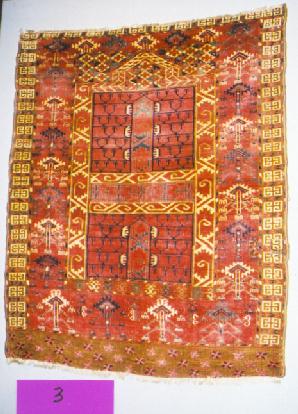
This first piece is an ensi, a door rug, in the usual hatchli format. There are some things that make this piece distinctive. First, nicely articulated "flower forms" used in the widest side borders, the elem and (in a more truncated version) across the top. Well-drawn versions of a "curled leaf" design in both white ground and red ground versions surround the four sections containing the "candalabras." But perhaps the nicest touch is the carefully contrived drawing of the arched section so that the horizontal band at its bottom moves seamlessly upward into the verticals that form the sides of the arch. This is a weaver working with great care.
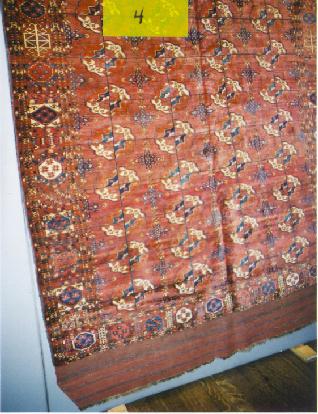
The carpet above is a detail of a Tekke main carpet. This photo does not do its color justice. Among its interesting features is the fact that the four-star cartouches are drawn with unusual variations and, in at least one instance, is replaced with another form altogether.

This drawing of this main border is also one where the weaver(s) used a rather wide variety of designs in the sections between the cartouches, in apparent virtuoso display of their weaving skills.
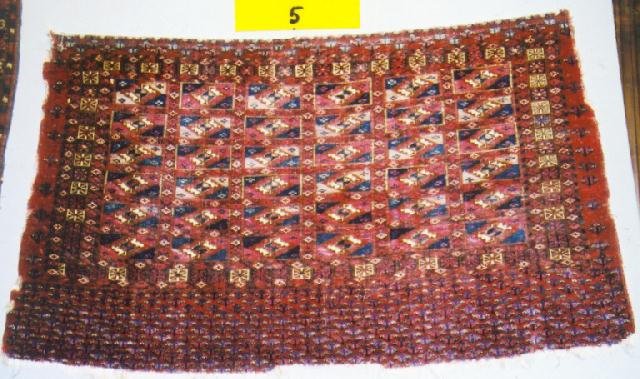
This is a Tekke chuval bag face with a compartmented design. The elem design is comprised of small flower forms more closely packed than is usual. Flower forms are also arrayed on both sides outside the main border above the elem and continue across the top.
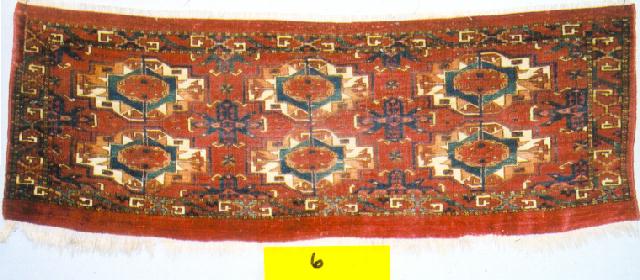
The piece above is a classic six-gul Tekke torba. The main border is very unusual and the dyes suggest that this piece was woven before 1850.
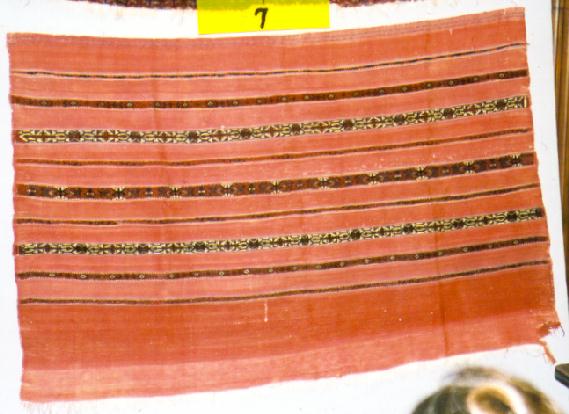
This is a large Tekke chuval of mixed technique. The red ground areas are flatweave but the bands are finely woven pile. Some ongoing studies of Turkmen pieces with mixed techniques indicate that the structures of these pile areas resemble those of Turkmen mixed technique tentbands. These structures also resemble those used in the very shaggy julkhyr sleeping rugs woven by non-Turkmen Central Asian weavers, in that they are woven on alternate raised warps only. This group of chuvals is divided into "ak" chuvals on which the elem has a white ground and "kizil" chuvals, which have red-ground elems. This piece is in the "kizil" group. Some writers see "kizil" chuvals as somewhat rarer than "ak" chuvals.
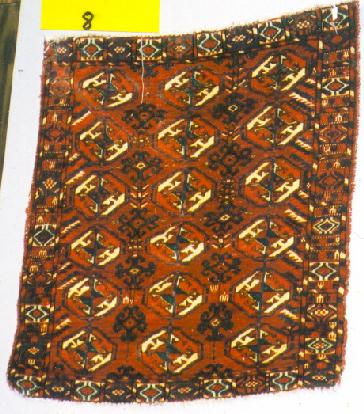
This piece above is a small Tekke rug with unusual octagonal guls and a main border that is also not seen frequently. The minor gul is unusual and has devices that appear to connect vertically in places.
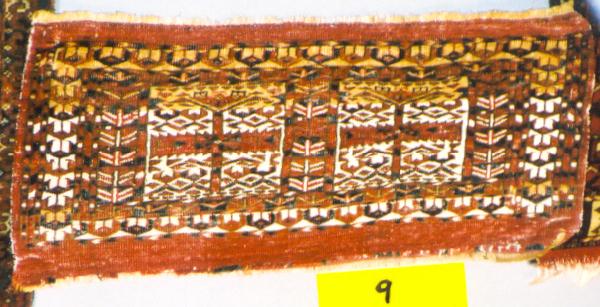
This small Tekke bag is of the "mafrash" size. Quality specimens in this format often show superior weaving, and are much sought by collectors. The main border design is a version of the so-called "bird on a pole" design and is also used by the Yomut. In its "one wing forward, one wing back" version, this design can be used in tesselated applications (ones in which the device entirely covers an area without any gaps or overlaps). There is a marked abrash in this piece in the shift from chalky white to ivory in the upper quarter.
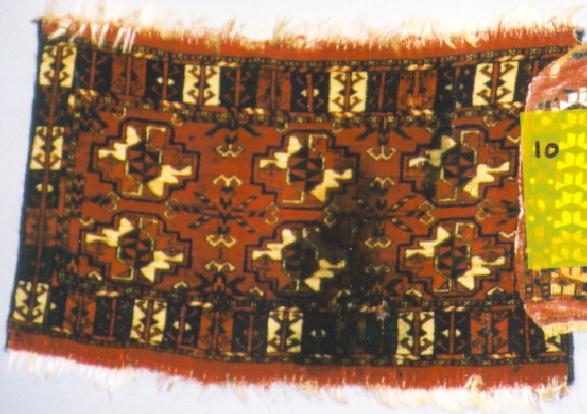
This small Tekke rug demonstrates how effectively Tekke weavers could use a small space for graphic effect. The border is unusual and the weaver has used white very skillfully. This little piece has great balance and a sense of completeness despite its size.
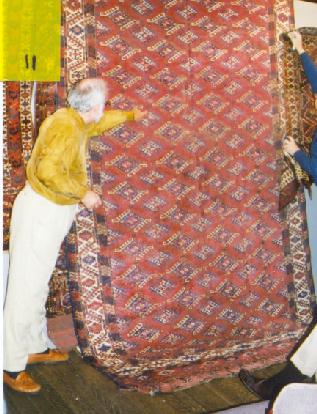
Dennis then moved to Yomut weaving. The image above is a large detail of a Yomut main carpet. The pile elems on this rug are worth a closer look
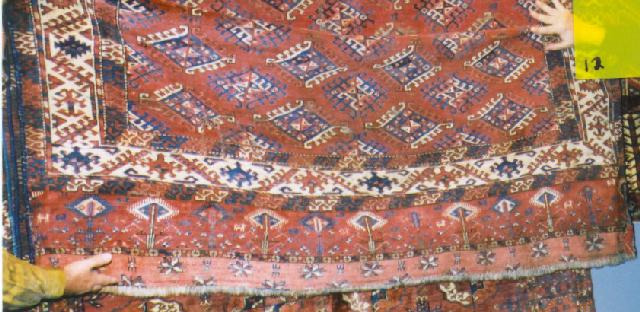
They exhibit quite beautiful versions of the "floral" forms often seen on the elems of chuval format bags.